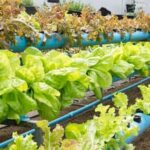School gardens are a valuable tool for introducing students to the joys of gardening and teaching them important lessons about nutrition, sustainability, and community involvement. Growing vegetables in a school setting not only provides an opportunity for hands-on learning but also encourages healthy eating habits and fosters a sense of responsibility and pride in students. In this article, we will explore the best vegetables for school gardens, along with planning tips, maintenance advice, and educational opportunities.
The benefits of school gardens are plentiful. Not only do they provide a practical application of science and environmental education, but they also offer an opportunity for students to connect with nature and learn where their food comes from. Additionally, school gardens can serve as a source of fresh produce for the school cafeteria or community programs. By choosing the right vegetables for your specific climate and growing conditions, you can ensure a successful and rewarding experience for everyone involved.
When planning your school garden, it is essential to involve students, teachers, and parents in the process. Assessing the space and resources available will help in determining what vegetables to grow. Furthermore, by engaging the entire school community in the planning process, you can create a sense of ownership and investment in the success of the garden project.
Planning Your School Garden
When it comes to planning a school garden, there are several important factors to consider in order to ensure a successful and thriving vegetable patch for students. One of the first steps in planning your school garden is to assess the space and resources available.
This includes taking stock of the available land, sunlight exposure, access to water, and any existing gardening supplies or infrastructure. By understanding these factors, you can make informed decisions about what vegetables will grow best in your specific climate and growing conditions.
Involving students, teachers, and parents in the planning process is also crucial for the success of a school garden. This can be achieved through organizing brainstorming sessions or workshops where everyone has the opportunity to contribute their ideas and preferences for what they would like to see grown in the garden. Additionally, involving students in the planning process can create a sense of ownership and responsibility for the garden, leading to greater enthusiasm and engagement with the project.
Choosing the right vegetables for your specific climate and growing conditions is essential for a successful school garden. When selecting which vegetables to grow, it’s important to take into consideration factors such as temperature, sunlight requirements, and soil quality.
Some of the best vegetables for school gardens include tomatoes, carrots, lettuce, bell peppers, cucumbers, green beans, radishes, and zucchini. These vegetables are relatively easy to grow and maintain, making them ideal for a school setting where students can actively participate in caring for the plants.
By carefully assessing your space and resources and involving all stakeholders in the planning process, you can set your school garden up for success from the very beginning. With thoughtful consideration of your climate and growing conditions as well as an intentional selection of vegetables that are well-suited for a school environment, you can create a thriving vegetable garden that engages students and enriches their educational experience.
Best Vegetables for School Gardens
Tomatoes, lettuce, and green beans are some of the best vegetables for school gardens. These vegetables are not only easy to grow, but they also offer a great opportunity for students to learn about plant life cycles, gardening practices, and healthy eating habits. When choosing the best vegetables for school gardens, it is important to consider the local climate and growing conditions to ensure a successful harvest.
One of the best vegetables for school gardens is tomatoes. Tomatoes come in a variety of colors and sizes, making them visually appealing to students. They can be grown in containers or directly in the ground, making them versatile for different garden setups. Lettuce is another great option for school gardens as it is easy to grow and matures quickly. This allows students to see the fruits of their labor in a relatively short amount of time.
Green beans are also among the best vegetables for school gardens due to their rapid growth and high yield. They can be grown vertically, making efficient use of space in a school garden setting. These three vegetables provide ample opportunities for hands-on learning experiences while also providing fresh produce that can be used in school meals or donated to those in need.
| Vegetable | Benefits |
|---|---|
| Tomatoes | Variety of colors and sizes; versatile for different garden setups |
| Lettuce | Easy to grow; matures quickly; visually appealing |
| Green Beans | Rapid growth; high yield; efficient use of space when grown vertically |
Easy-to-Grow Vegetables for Kids
There are a variety of vegetables that are perfect for school gardens, especially when it comes to choosing options that are easy to grow and maintain, and that kids will enjoy. Here are some of the best vegetables for school gardens that are particularly suitable for children to plant and take care of.
Cherry Tomatoes
Cherry tomatoes are an excellent choice for school gardens because they yield a bountiful harvest and are relatively low-maintenance. Kids love picking cherry tomatoes straight from the vine and popping them into their mouths – it’s a fun and rewarding experience for them.
Snap Peas
Snap peas are another great vegetable for school gardens, as they’re easy to grow and don’t require much space. The kids will enjoy getting to pick the snap peas right off the vine and munching on them as a healthy snack during the school day.
Strawberries
Strawberries are always a hit with kids, making them an ideal choice for school gardens. They’re relatively easy to grow and provide a sweet reward for the children who help tend to them. Plus, strawberries can be used in various dishes in the school cafeteria or even enjoyed as part of a fresh fruit snack.
Sunflowers
While not a vegetable per se, sunflowers can be a fun addition to any school garden. They’re easy to grow from seed, reaching impressive heights that kids will find fascinating. Sunflowers also attract pollinators, adding an educational aspect to their presence in the garden. Watching these vibrant flowers bloom can teach students about the life cycle of plants while adding beauty to the garden space.
By introducing these easy-to-grow vegetables into your school garden, you’ll not only provide kids with enriching hands-on experiences but also encourage healthy eating habits and an appreciation for nature at an early age.
Tips for Maintaining Your School Garden
Maintaining a school garden requires regular attention and care to ensure that the vegetables thrive and provide a successful learning environment for students. Here are some tips for keeping your school garden in top shape:
- Watering and fertilizing: It’s important to establish a regular watering schedule for the school garden, especially during hot weather. Additionally, using organic fertilizers can help provide essential nutrients to the soil and promote healthy vegetable growth.
- Pest control: Keeping an eye out for pests and diseases is crucial in maintaining a productive school garden. Encourage students to inspect the plants regularly for any signs of damage or infestation, and consider natural pest control methods such as companion planting or introducing beneficial insects like ladybugs.
- Harvesting and replanting: Teach students about the proper way to harvest vegetables to ensure that new growth continues throughout the season. Additionally, once a crop has been harvested, involve students in the process of replanting new seeds or seedlings to keep the garden productive.
In addition to these maintenance tasks, having a structured garden maintenance schedule can help ensure that all necessary tasks are completed on time. This could involve designating specific days for weeding, watering, and other upkeep activities.
By following these maintenance tips, your school garden will continue to flourish and provide valuable educational experiences for students.
Incorporating Garden Produce Into School Meals
One of the most rewarding aspects of having a school garden is being able to incorporate the fresh produce into school meals. Working with the school cafeteria to include vegetables and fruits grown on the premises not only provides students with nutritious options but also connects them to the food they eat in a meaningful way. By involving students in the process of growing and harvesting vegetables, they gain a greater appreciation for healthy eating and sustainable food practices.
Schools can organize cooking and tasting sessions for students, where they can learn how to prepare simple dishes using the garden produce. This not only teaches valuable cooking skills but also encourages students to try new foods that they may have been reluctant to taste before. Additionally, creating a school farmers’ market where excess produce can be sold or exchanged among students and staff can further promote healthy eating habits and community building.
By including garden-grown vegetables in school meals, students are exposed to a wide variety of fresh, local produce that they may not encounter otherwise. This promotes a sense of connection to their environment and an understanding of where their food comes from, supporting sustainability education goals within the school curriculum. Overall, incorporating garden produce into school meals is an effective way to encourage healthy eating habits and strengthen the relationship between students and their food.
It’s important to remember that involving students in meal planning, preparation, and consumption can have lasting effects on their dietary choices outside of school. By integrating garden-grown vegetables into their daily meals at school, we can help establish lifelong healthy habits for our students. Thus, choosing the best vegetables for school gardens becomes essential in providing fresh produce for incorporation into school meals while ensuring that it meets both nutritional standards and student preferences.
Educational Opportunities
Once your school garden starts producing a bountiful harvest, it’s time to explore how to incorporate the fresh vegetables into school meals. Working with the school cafeteria is a great way to ensure that the produce from the garden is utilized. Many schools have successfully incorporated garden-grown produce into their lunch menus, creating healthy and nutritious options for students.
Another way to involve students in this process is to organize cooking and tasting sessions using the vegetables harvested from the garden. This allows students to learn about nutrition and healthy eating habits while also gaining valuable culinary skills.
Additionally, creating a school farmers’ market can be an exciting way to showcase and sell the fruits of your gardening labor. This not only provides an opportunity for hands-on learning about marketing and entrepreneurship, but also encourages the school community to support local, sustainable produce.
- Science lessons in the garden
- Math and measurement activities
- Sustainability and environmental education
| Benefit | Data |
|---|---|
| Increase in fruit and vegetable consumption | Research has shown that when children are involved in growing their own food, they are more likely to try new fruits and vegetables. |
| Reduction in food waste | By incorporating garden produce into meals, schools can reduce food waste by using what they grow rather than purchasing additional produce. |
| Positive impact on student health | Introducing fresh, homegrown produce into school meals can contribute to improved overall health among students. |
Community Involvement
School gardens not only benefit the students and teachers but also provide an opportunity for community involvement. By engaging local businesses and organizations, schools can establish valuable partnerships that support the growth and sustainability of their vegetable gardens.
Hosting community garden events is a great way to showcase the hard work put into the school garden and to encourage community members to get involved. These events can include activities such as gardening workshops, cooking demonstrations using garden produce, or even a farmers’ market featuring the school’s fresh vegetables.
In addition to community events, schools can also give back to the local community by donating excess produce to those in need. This not only teaches students about the importance of giving back but also helps address issues of food insecurity in the local area. By partnering with local food banks or shelters, schools can make a positive impact on their community while also reducing food waste from their gardens.
Overall, involving the community in school garden initiatives fosters a sense of pride and ownership in both the school and the neighborhood. It creates opportunities for learning beyond the classroom walls and emphasizes the importance of working together for a common cause-whether it’s promoting sustainability or helping those in need.
- Engaging local businesses and organizations
- Hosting community garden events
- Donating excess produce to those in need
Conclusion
In conclusion, incorporating vegetable gardens into school settings provides numerous benefits for students, teachers, and the community as a whole. Not only do school gardens offer a hands-on opportunity for students to learn about plant life cycles and the importance of healthy eating, but they also provide a sense of ownership and responsibility for the care of the garden.
The best vegetables for school gardens are those that are easy to grow and maintain, such as tomatoes, carrots, lettuce, bell peppers, cucumbers, green beans, radishes, and zucchini.
It is essential to remember that involving students in the planning and maintenance of the garden is crucial to its success. By educating them on proper care techniques and involving them in decision-making processes, they will develop a deeper appreciation for the fruits of their labor. Additionally, incorporating garden produce into school meals or hosting cooking and tasting sessions further reinforces the educational opportunities provided by these gardens.
Overall, school gardens have the potential to teach valuable life skills while promoting healthier eating habits and environmental stewardship among students. As we conclude, we encourage more schools to consider starting their own vegetable gardens for the benefit of their students and communities as a whole. The impact of these gardens extends beyond just providing fresh produce; it fosters a sense of community involvement and environmental responsibility that will benefit everyone involved.
Frequently Asked Questions
What’s the Easiest Vegetable to Grow for Kids?
The easiest vegetable to grow for kids is probably the cherry tomato. It’s small, easy to care for, and produces plenty of sweet, bite-sized fruits that kids love to pick and eat straight off the vine.
What Is a Kid Friendly Vegetable Garden?
A kid-friendly vegetable garden is one that includes a variety of colorful and tasty vegetables that children will enjoy growing and eating. Vegetables like carrots, snap peas, cucumbers, and colorful bell peppers are all great options for a kid-friendly garden.
How Do I Start a School Vegetable Garden?
To start a school vegetable garden, you’ll need to gather support from teachers, parents, and local community members. You’ll also need to choose an appropriate location, prepare the soil, and decide what vegetables to grow based on the climate and season.
Plus, it’s important to involve the students in every step of the process to ensure their engagement and enthusiasm for the project.

If you’re looking to get into vegetable gardening, or are just looking for some tips on how to make your current garden better, then you’ve come to the right place! My name is Ethel and I have been gardening for years. In this blog, I’m going to share with you some of my best tips on how to create a successful vegetable garden.





